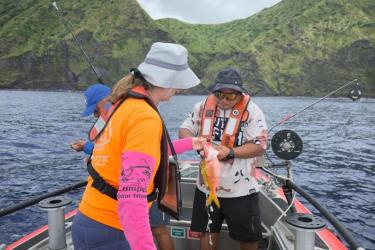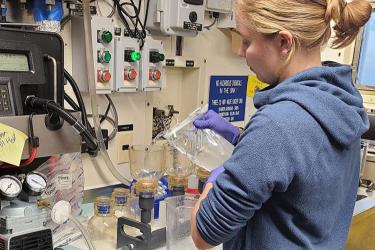The Secretary of Commerce announced the allocation of $300 million in fisheries assistance funding provided by Sec. 12005 of the Coronavirus Aid, Relief, and Economic Security Act, also called the CARES Act, to states, Tribes, and territories with coastal and marine fishery participants who have been negatively affected by COVID–19.
“This relief package will support America’s fishermen and our seafood sector’s recovery,” said U.S. Department of Commerce Secretary Wilbur Ross. “Thank you President Trump, Secretary Mnuchin, and our Congressional leaders of both parties for your work to pass the historic legislation that is bringing much needed relief to America’s fishermen. This Administration stands with the men and women working to provide healthy and safe seafood during this uniquely challenging time, while our U.S. fisheries work to continue to support 1.7 million jobs and to generate $200 billion in annual sales. The nation is grateful to our fishermen for their commitment.”
As a next step, NOAA Fisheries will use these allocations (see below) to make awards to our partners: the Atlantic States Marine Fisheries Commission, the Pacific States Marine Fisheries Commission, the Gulf States Marine Fisheries Commission, Puerto Rico, and the U.S. Virgin Islands. They will disburse the funds to address direct or indirect fishery-related losses as well as subsistence, cultural, or ceremonial impacts related to COVID-19.
“We are going to rely primarily on our partners at the interstate marine fishery commissions during the award process because they have a demonstrated track record of disbursing funds provided to them quickly and effectively,” said Chris Oliver, Assistant Administrator for NOAA Fisheries.
The commissions then will work with each state, Tribe, and territory to develop spend plans consistent with the CARES Act and NOAA’s guidance. Puerto Rico and the U.S. Virgin Islands will submit award applications and spend plans to the agency directly. All spend plans must describe the main categories for funding, including direct payments, fishery-related infrastructure, and fishery-related education that address direct and indirect COVID-19 impacts to commercial fishermen, charter businesses, qualified aquaculture operations, subsistence/cultural/ceremonial users, processors, and other fishery-related businesses. Once a spend plan has been approved by NOAA, the agency anticipates that the three Commissions will review applications and process payments to eligible fishery participants on behalf of the states and territories. The states will have the option to process payments themselves.
Fishery participants eligible for funding include Tribes, commercial fishing businesses, charter/for-hire fishing businesses, qualified aquaculture operations, processors, and other fishery-related businesses. They should work with their state marine fisheries management agencies, territories, or Tribe to understand the process for applying for these funds.
Also of note, for the purposes of Sec. 12005 funding, businesses farther down the supply chain—including vessel repair businesses, restaurants, or seafood retailers—are not considered “fishery-related businesses.”
Summary of Allocations*
Entity | Allocation of Sec. 12005 Funding |
| Alaska | $50,000,000 |
| Washington | $50,000,000 |
| Massachusetts | $28,004,176 |
| Florida | $23,636,600 |
| Maine | $20,308,513 |
| California | $18,350,586 |
| Oregon | $15,982,827 |
| Louisiana | $14,785,244 |
| New Jersey | $11,337,797 |
| Texas | $9,237,949 |
| New York | $6,750,276 |
| North Carolina | $5,460,385 |
| Federally Recognized Tribes on the West Coast | $5,097,501 |
| Virginia | $4,520,475 |
| Hawaii | $4,337,445 |
| Maryland | $4,125,118 |
| Pennsylvania | $3,368,086 |
| Alabama | $3,299,821 |
| Rhode Island | $3,294,234 |
| New Hampshire | $2,732,492 |
| American Samoa | $2,553,194 |
| Georgia | $1,921,832 |
| Connecticut | $1,835,424 |
| Mississippi | $1,534,388 |
| South Carolina | $1,525,636 |
| Delaware | $1,000,000 |
| Puerto Rico | $1,000,000 |
| United States Virgin Islands | $1,000,000 |
| Federally Recognized Tribes in Alaska | $1,000,000 |
| Guam | $1,000,000 |
| Commonwealth of the Northern Mariana Islands | $1,000,000 |
| Total |
$300,000,000
|
* Final award amounts will be different due to Hollings and other assessments.
CARES Act Funding Questions
Q. Who should affected fishermen and communities contact about accessing this funding?
A. Fishery participants eligible for funding—including Tribes, commercial fishing businesses, charter/for-hire fishing businesses, qualified aquaculture operations, processors, and other fishery-related businesses—should work with their state marine fisheries management agencies, territories, or Tribe to understand the process for applying for these funds.
Q. Can eligible fishery participants receive direct payments?
A. Direct payments are expressly allowed under Sec. 12005 of the CARES Act. Each Commissions’ grant application must meet the requirements of the CARES Act and reflect the appropriate use of funds and considerations as outlined in the Request for Applications, the Request for Applications letter and the allocation table provided.
Q. How long will it take for affected fishermen to get funding from the CARES Act?
A. It will vary, however we expect that Sec. 12005 funding will be disbursed more quickly than fishery disaster assistance funds because the CARES Act language does not require the Secretary of Commerce to declare a fishery disaster. The CARES Act also allows the funds to be awarded on a “rolling basis,” which will enable NOAA Fisheries to execute the funds more nimbly in partnership with the states, Tribes, and territories.
Q. What types of fishing-related businesses are eligible for assistance?
A. For the purposes of carrying out the provisions in Section 12005 of the CARES Act, “fishery-related businesses” primarily include commercial fishing businesses, charter/for-hire fishing businesses, qualified aquaculture operations, processors, and dealers. States, Tribes, and territories have the discretion to determine whether marine bait and tackle operations and marine gear and vessel suppliers are eligible for Sec. 12005 assistance in their spend plans, consistent with the requirements of the CARES Act. Businesses farther down the supply chain—including vessel repair businesses, restaurants, or seafood retailers—are not considered “fishery-related businesses” for the purposes of this funding.
Q. Which Tribes are eligible for assistance?
A. The definition of “fishery participant” identified in Sec. 12005 of the CARES Act, includes Tribal fishery participants. So, Tribes in coastal states with marine or anadromous fisheries and/or marine shellfish or finfish aquaculture operations are eligible for Sec. 12005 funds. Tribes in non-coastal states with freshwater fisheries will not be eligible for Sec. 12005 funds.
Q. Which types of aquaculture operations are eligible for funding?
A. Privately owned aquaculture businesses growing products in state or federal marine waters of the United States and the hatcheries that supply them are eligible for Sec. 12005 funding. Sec. 12005 funds include all molluscan shellfish and marine algae, as well as non-salmonid marine finfish. USDA recently expanded aid under its Coronavirus Food Assistance Program 2 (CFAP 2) to include any species of aquatic organisms grown as food for human consumption. As a result of these changes, individual aquaculture businesses that receive Section 12005 CARES Act funds may also receive CFAP 2 funds. All aquaculture businesses must also meet the eligibility requirements specified in the CARES Act and in their state’s spend plan.
Q: On what basis did the agency make the initial allocation decision? What data did the NOAA Fisheries use for the initial allocation decision?
A: To allocate the Sec. 12005 funds, NOAA Fisheries used a methodology that met our overriding goal to distribute the Sec. 12005 funds as quickly as possible while accounting for regional variability in the size of commercial, charter, seafood processors and dealers, and aquaculture industries.
Given the definition of “fishery participant” identified in Sec. 12005 of the CARES Act, NOAA Fisheries used readily available total annual revenue information from the commercial fishing, charter fishing, aquaculture, and seafood-related businesses of coastal states, Tribes, and territories to proportionately allocate the Sec. 12005 funding. NOAA Fisheries also took into consideration negative impacts to subsistence, cultural, and ceremonial fisheries during the allocation process.
NOAA Fisheries used readily available multi-year averages to estimate the total average annual revenues from commercial fishing operations, aquaculture firms, the seafood supply chain (processors, dealers, wholesalers and distributors) and charter fishing businesses from each coastal state, Tribe, and territory. The table below provides the proportion of revenue attributable to the specified sectors. Additional details regarding the sources of revenue data are included below:
- Commercial fishing revenues: For most states, NOAA Fisheries used a five-year average of annual commercial fishing revenues from 2014-2018 based on data obtained from NOAA Fisheries’ Office of Science and Technology’s commercial landings database. For U.S. territories, five year average commercial fishing revenues from 2014-2018 were obtained from the Fisheries of the United States report.
- Aquaculture revenues: Most aquaculture revenue data was embedded within the commercial landings revenue data used to calculate five year average commercial fishing revenues. Updated USDA Census of Aquaculture data was used to account for aquaculture sales not accounted for within commercial fishing landings data (e.g., oysters, mussels, clams from select states). Multi-year averages were not available for aquaculture sales derived from the USDA Census of Aquaculture data.
- Seafood Sector revenues: The commercial fishing landings revenue and aquaculture sales (defined as described above) were used to calculate direct value-added estimates for the seafood sector (i.e., processors, dealers, and wholesalers/distributors) using NOAA Fisheries’ Commercial Fishing & Seafood Industry Economic Impact Model, while Alaska and West Coast direct value added estimates were calculated from regional models. Direct value added is essentially sales revenue less the cost of seafood inputs. This metric ensures that revenue was not double counted in both the commercial and seafood sectors and that expenditures that flow out of the country from imported seafood products were not included in any revenue estimates.
- For-hire fishing revenues: For most states, average for-hire fishing revenues from 2015-2019 were based on angler payments to for-hire operations for fishing trips. Data on angler payments were based on NOAA Fisheries’ Angler Expenditures Surveys and data on directed for-hire fishing trips were derived from NOAA Fisheries’ Marine Recreational Information Program. For Hawaii, Alaska, and the Caribbean territories, NOAA Fisheries used charter vessel cost earnings surveys.
All sales and value added data was converted into 2019 dollars. Several additional adjustments were made to the data described above to account for specific aspects of fisheries. For example:
- Average annual landings revenue data from Alaska, New England, and Mid-Atlantic states were adjusted to attribute landings in those regions to a vessel owner’s state of residence to better reflect where fishing income accrues. These adjustments were made by determining the proportion of landings in a particular state attributed to vessel owners residing in another state and distributing revenue accordingly. A similar adjustment was also applied to at-sea processors on the West Coast but was not applied broadly to other fisheries on the West Coast or Pacific Islands, Southeast, and Gulf of Mexico fisheries, because comparable state-by-state vessel ownership data was not readily available. In addition, because those regions represent a relatively small proportion of the nation’s total commercial fishery landings revenues and are smaller in scale relative to Alaska fisheries and the West Coast at-sea processors, adjustments in those regions would not significantly impact the overall allocation across all applicable states, Tribes, and territories.
- A multiplier was also applied to available multi-year averages of Tribal and territorial commercial fishing operations to account for commercial, subsistence, cultural, and ceremonial fisheries.
NOAA Fisheries proportionally allocated Sec. 12005 funds based on the total average annual revenues from coastal states, Tribes, and territories. The general formula used is included below. However, NOAA Fisheries also applied a minimum and maximum funding level ($1 million and $50 million, respectively).




